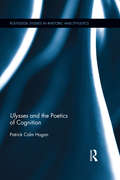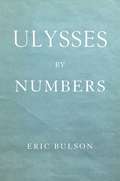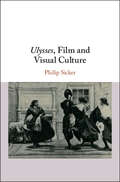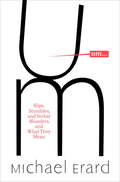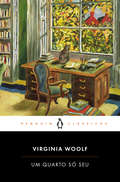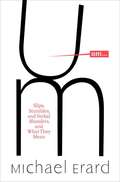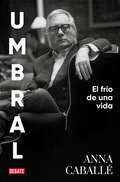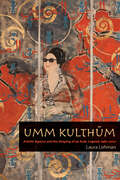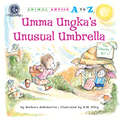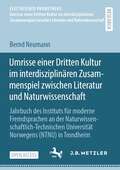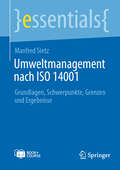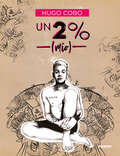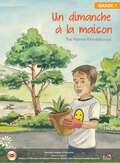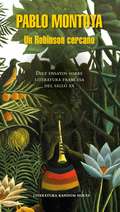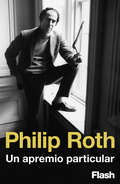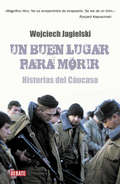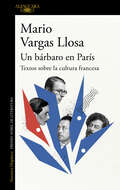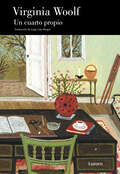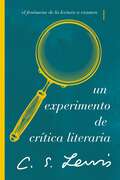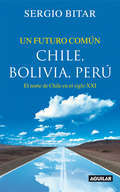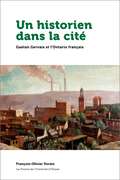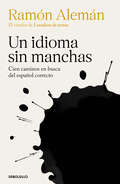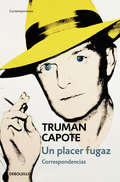- Table View
- List View
Ulysses and the Poetics of Cognition: Ulysses And The Poetics Of Cognition (Routledge Studies in Rhetoric and Stylistics)
by Patrick Colm HoganGiven Ulysses’ perhaps unparalleled attention to the operations of the human mind, it is unsurprising that critics have explored the work’s psychology. Nonetheless, there has been very little research that draws on recent cognitive science to examine thought and emotion in this novel. Hogan sets out to expand our understanding of Ulysses, as well as our theoretical comprehension of narrative—and even our views of human cognition. He revises the main narratological accounts of the novel, clarifying the complex nature of narration and style. He extends his cognitive study to encompass the anti-colonial and gender concerns that are so obviously important to Joyce’s work. Finally, through a combination of broad overviews and detailed textual analyses, Hogan seeks to make this notoriously difficult book more accessible to non-specialists.
Ulysses by Numbers
by Eric Jon BulsonUlysses has been read obsessively for a century. What if instead of focusing on the words to understand the structure, design, and history of Joyce’s masterpiece, we pay attention to the numbers?Taking a computational approach, Ulysses by Numbers lets us see the novel’s basic building blocks in a significantly new light—words, paragraphs, pages, and characters, as well as the original print run and the dates marking the beginning and end of its composition. Numbers provide access into Joyce’s creative process, enhanced by graphs, diagrams, timelines, and maps, and they also give us a startling new perspective on the proportions that continue to structure, organize, and pace the reading experience. Numbers are there to help us navigate the history of Ulysses from its earliest material beginnings, and they offer a concrete basis upon which we can explore the big questions about its length, style, origins, readership, and design.An innovative computational reading on both a micro and macro level, Ulysses by Numbers is a timely intervention into debates about the use and abuse of quantitative methods in literary analysis. Eric Bulson demonstrates how reading by numbers can bring us closer to the words of Ulysses, helping us rediscover a novel we thought we already knew.
Ulysses on the Liffey
by Richard EllmannThe author of modern biographies lucidly disentwines the narrative, ethical, aesthetic, and ultimate levels of James Joyce's masterpiece Ulysses. Much of the evidence is internal, but he also makes the first use of some important indications by Joyce himself.
Ulysses, Film and Visual Culture
by Philip SickerAlthough Joyce was losing his sight when he wrote Ulysses, Stephen's and Bloom's visual experiences are extraordinarily rich and complex. Absorbing the influences of popular visual attractions such as dioramas, stereoscopes and mutoscopes, their perceptions of Dublin are shaped by what Walter Benjamin calls 'unconscious optics'. Analyzing closely the texture of their impressions and of Joyce's prismatic narrative styles, Philip Sicker explores the phenomenon of sight from a wide-ranging set of perspectives: eighteenth-century epistemology (Locke and Berkeley), theories of the flaneur (Baudelaire and Benjamin), Italian Futurist art (Marinetti and Boccioni), photography (Barthes and Sontag), and the silent films Joyce watched in Dublin and Trieste. The concept of 'spectacle' as a mechanically-constructed visual experience informs Sicker's examination of mediated perception and emerges as a hallmark of modernist culture itself. This study is an important contribution to the growing interest in how deeply the philosophy and science of visual perception influenced modernism.
Um . . .: Slips, Stumbles, and Verbal Blunders, and What They Mean
by Michael ErardIn this account of language in the wild, linguist and writer Michael Erard explains why our attention to some verbal blunders rises and falls. Why was the spoonerism named after Reverend Spooner and not some other absentminded person? Where did the Freudian slip come from? Why do we prize "umlessness" in speaking? And how do we explain the American presidents who are famous for their verbal blundering? You'll have new ways to listen to yourself and others once you've met the people who work with verbal blunders every day - journalists, transcribers, interpreters, police officers, linguists, and psychologists, among others - and once you've learned what verbal blunders tell us about who we are and what we want
Um Quarto Só Seu
by Virginia WoolfCONSIDERADO UM DOS TEXTOS MAIS IMPORTANTES DO SÉCULO XX, UM QUARTO SÓ SEU MARCA UM MOMENTO FUNDADOR DO FEMINISMO MODERNO. UM ENSAIO MARCANTE DE UMA AUTORA INCONTORNÁVEL DO PENSAMENTO MODERNO, VIRGINIA WOOLF, AGORA NOS PENGUIN CLÁSSICOS. COM PREFÁCIO DE ANA LUÍSA AMARAL. «Tranquem as vossas bibliotecas se quiserem; mas não há portão, não há cadeado, não há ferrolho com que possam prender a liberdade do meu espírito.» Em 1928, Virginia Woolf foi convidada pela Universidade de Cambridge a dar, nos colégios femininos da instituição, uma palestra sobre mulheres e ficção. Com a frontalidade que o tema exige, Woolf resolve, sem subterfúgios, a equação: para escrever ficção, «uma mulher tem de ter dinheiro e um quarto só seu». Dito de outro modo, tem de ser livre. Versando sobre as condições materiais e sociais necessárias para que uma mulher possa, se assim o desejar, escrever e criar, e explorando os efeitos da pobreza e do constrangimento sexual na criatividade feminina, Virginia Woolf ofereceu ao seu auditório e a todas as gerações que se seguiram uma reflexão provocadora e estimulante sobre a condição da mulher e a alienação social a que foi, desde a Antiguidade, sujeita num mundo dominado por homens. Considerado um dos textos mais importantes do século XX, Um Quarto Só Seu marca um momento fundador do feminismo moderno, que devolve à esfera política uma luta antiga e justa: a da igualdade.
Um...Slips, Stumbles, and Verbal Blunders, and What They Mean
by Michael ErardJournalist and language expert Erard argues that the secrets of human speech are present in our verbal blunders as he studies and interprets speech errors--hilarious bloopers, Spoonerisms, and malapropisms.
Umbral: El frío de una vida
by Anna CaballéCrónica de un dandy español en el 15 aniversario de su muerte. La publicación de El frío de una vida, en 2004, marcó un antes y un después en el dominio del género de la biografía española. La brillante y rigurosa interpretación que se hacía de la escritura umbraliana a partir de los obstáculos y dificultades reales que no dejaron de asediar al escritor a lo largo de su vida (1932-2007) -y que hasta entonces habían permanecido ocultos- supuso una novedad y también un desafío. Anna Caballé fijó las circunstancias en las que transcurrieron la infancia y adolescencia de Francisco Umbral y su llegada a Madrid. También analizó y contextualizó en profundidad su incansable labor como articulista y escritor y su relación con las mujeres y el poder, todo ello construido en el libro con una pasión contenida que, sin embargo, es siempre muy perceptible en el estilo de la autora. El resultado fue un libro iluminador, valiente y arriesgado que huía de los cumplidos para exponer los hechos más relevantes de la vida de Umbral, sin obviar tampoco una posible interpretación de los mismos. La biografía de un escritor vivo como no se había escrito hasta entonces en España. Casi veinte años después de aquella edición, se reedita revisada y con los imprescindibles ajustes que incluyen el cierre de los interrogantes que en la primera edición quedaron sin resolver.
Umm Kulthum: Artistic Agency and the Shaping of an Arab Legend, 1967–2007 (Music Culture)
by Laura LohmanHow an extraordinary woman shaped her career and legacy through war In 1967 Egypt and the Arab world suffered a devastating defeat by Israel in the Six-Day War. Though long past the age at which most singers would have retired, the sexagenarian Egyptian singer Umm Kulthum launched a multifaceted response to the defeat that not only sustained her career, but also expanded her international fame and shaped her legacy. By examining biographies, dramas, monuments, radio programming practices, and recent recordings, Laura Lohman delves into Umm Kulth m's role in fashioning her image and the conflicting ways that her image and music have been interpreted since her death in 1975.
Umma Ungka's Unusual Umbrella (Animal Antics A to Z)
by Barbara deRubertisUmma Ungka stumbles and bumbles. She trips and tumbles! The summer sun is making her feel dizzy and muddled! But Uncle Ungka might have just the solution to keep Umma cool as a cucumber all summer long.
Umrisse einer Dritten Kultur im interdisziplinären Zusammenspiel zwischen Literatur und Naturwissenschaft: Jahrbuch des Instituts für moderne Fremdsprachen an der Naturwissenschaftlich-Technischen Universität Norwegens (NTNU) in Trondheim (ELECTRISCHER PROMETHEUS. Umrisse einer Dritten Kultur im interdisziplinären Zusammenspiel zwischen Literatur und Naturwissenschaft)
by Bernd NeumannIn diesem Open-Access-band geht es um die Thematisierung des Verhältnisses zwischen den gegenwärtig getrennten „Zwei Kulturen“ und Umrisse ihrer neuen Synthese in Richtung auf eine zeitgenössische, auf Interdisziplinarität gegründeten „Dritten Kultur“ als Zusammenschau von Literaturwissenschaft, Philosophie und Naturwissenschaft. Dabei wird Kafka als ein Autor ernst genommen, dessen Nähe zu Autoren der Romantik (Kleist etwa als einer seiner „Blutsbrüder“) ihn dazu bestimmte, deren zentrales Interesse an der Elektrizität (in Form des Mesmerismus beispielsweise) zu teilen. Als eine Weiterführung hinein in die neueste Moderne gelangt Kafkas besondere Begegnung mit Einstein und dessen Relativitätstheorie zur Darstellung, deren Einwirkung insbesondere auf Kafkas Spätwerk dargelegt wird. Als moderne Spielform solch „electrisch“- transdisziplinär orientierten literarischen Schreibens wird diesen Ausführungen Botho Strauß` gegenwärtiges Novellenwerk zur Seite gestellt.
Umweltmanagement nach ISO 14001: Grundlagen, Schwerpunkte, Grenzen und Ergebnisse (essentials)
by Manfred SietzUmweltmanagement eines Unternehmens bedeutet, die Umweltauswirkungen minimierend zu managen, um die Qualität unserer Umwelt zu erhalten oder zu verbessern. Managen bedeutet in der Originalübersetzung etwas zu verwalten. Also eine Aufgabe mit Verantwortung, Zielen und Aktivitäten. Alle diese Managementtools werden zuzusammengefasst in der weltweit gültigen und zertifizierbaren Norm ISO 14001.
Un 2% (mío)
by Hugo CoboHugo Cobo, exconcursante de Operación Triunfo, nos trae su proyecto más personal. Las personas somos como los icebergs: dejamos ver una pequeña parte de nosotros, pero ocultamos otra mucho mayor bajo el agua . Es allí donde se encuentran nuestros sueños, nuestros miedos, los mejores momentos de nuestras vidas, las partes más difíciles... y lo que queda en la superficie es solo un 2% de todo eso. Hay que ser valiente para atreverse a bucear y descubrir qué se esconde más allá de lo que está a simple vista. Tienes entre tus manos esa parte oculta de mí, ese "yo" desconocido, todo lo que viene después del 2% que ves.
Un Dimanche à la Maison class 1 - MIE
by Par Hanna Khodabocus"Un Dimanche à la Maison" présente une journée dans la vie de Kevin, un jeune garçon, et de sa famille lors d'un dimanche ordinaire. Le récit débute par les salutations matinales de Kevin à sa mère et sa famille avant de commencer sa journée. Il décrit sa routine quotidienne, partageant ses moments passés avec son frère, sa sœur, son père devant la télévision, et avec son grand-père dans le jardin. Pendant ce temps, sa grand-mère et sa mère se reposent sur la terrasse. Le livre souligne les activités familiales, les interactions et les responsabilités quotidiennes tout en mettant en avant les moments de détente et de partage. À la fin de cette journée, Kevin se prépare pour la rentrée scolaire du lendemain. Ce livre, conçu pour les jeunes lecteurs, offre un aperçu de la vie domestique typique d'une famille, encourageant les enfants à identifier et à comprendre les activités quotidiennes et les relations familiales.
Un Robinson cercano: Diez ensayos sobre literatura Francesa del siglo XX
by Pablo MontoyaEn estos ensayos, Pablo Montoya, Premio Rómulo Gallegos 2014, reflexiona sobre la vida y la obra de varios de los grandes escritores franceses del siglo XX En estos ensayos, Pablo Montoya, Premio Rómulo Gallegos 2014, reflexiona sobre la vida y la obra de varios de los grandes escritores franceses del siglo XX Los escritos aquí reunidos constituyen una mirada crítica a la obra de diez de los escritores galos más destacados del siglo pasado como Albert Camus, André Gide, Michel Houellebecq y Marguerite Yourcenar. Abordados desde perspectivas originales, inteligentes y escritos con una prosa paciente y muy rica, estos ensayos son, además, una franca invitación al lector a sumirse en una de las literaturas más fascinantes del siglo pasado.
Un apremio particular
by Philip RothFlash recupera la entrevista de Philip Roth en The Paris Review, una ventana magistral a los inicios de la carrera del maestro de la narrativa estadounidense. En 1984 The Paris Review publicaba esta entrevista, en la que Philip Roth hacía un repaso por varias de las obras más destacadas de su bibliografía que lo convertirían en un mito. En ella hablaba de la difusa línea entre la realidad y la ficción, de la influencia del psicoanálisis y de las mujeres en su escritura, de su proceso creativo, que se asienta en un profundo compromiso diario con la palabra, y de la relación entre el genio y la persona en la figura de los narradores. El resultado era un compendio de respuestas únicas y cautivadoras, como sus propios textos, que mostraban una personalidad caleidoscópica. Roth lector, Roth amigo, Roth amante, Roth creador; todas sus facetas convergían en una entrevista sincera e interesante que descubrió a sus seguidores cómo se gestó el maestro de la narrativa estadounidense. «Para mí escribir no es algo natural que sigo haciendo, a la manera en que los peces nadan y los pájaros vuelan. Es algo que hago bajo cierta clase de provocación, un apremio particular. Es la transformación, mediante una complicada actuación, de una emergencia personal en un acto público (en los dos sentidos de la palabra)». De ¿Por qué escribir? se dijo:«En un momento en el que parece que cuestionamos cada afirmación, es una lectura esencial».Jonathan Lethem «Un clásico que engancha, un deleite de principio a fin, una fiesta en tu cabeza».Mary Karr «Consistentemente inteligente y entretenido».The Wall Street Journal «En la actual literatura norteamericana está Philip Roth y, después, todos los demás».Chicago Tribune «Es un festín para la inteligencia. Divertido, irreverente, lúcido, imprevisible».Rafael Narbona, El Cultural de El Mundo
Un buen lugar para morir: Historias del Cáucaso
by Wojciech JagielskiA medio camino entre el reportaje y el libro de viaje, las crónicas del renombrado periodista polaco, considerado sucesor del gran Ryszard Kapuscinski. En agosto de 2008, Georgia saltaba a las primeras páginas de la prensa internacional por una breve e insensata guerra contra Rusia. Un conflicto incomprensible para muchos, pero cuyas raíces se hunden en la década de 1990. En ese momento, cuando la atención de la prensa internacional se fijaba en el conflicto de los Balcanes, Wojciech Jagielski decidió enfrentarse -prácticamente en solitario- a otro de los puntos calientes del planeta: el Cáucaso, una franja de tierra de reducido tamaño estratégicamente situada entre Asia y Europa y con abundantes reservas de petróleo. Devastado por los conflictos derivados del desmantelamiento de los grandes imperios del siglo XX y por las contradicciones propias de la desaparición de las ideologías que lo habían gobernado, el Cáucaso se desangraba en una guerra entre nacionalismos fanatizados, cuyos coletazos aún vemos. Con el pulso firme y el brillante estilo periodístico de su maestro Kapuscinski, Jagielski describe el sinsentido desatado en este olvidado y desconocido rincón del mundo, simbolizado entre los muros de un manicomio, donde enfermos de todas las nacionalidades convivían pacíficamente ajenos a la locura desatada en el exterior. Reseña:«Magnífico libro. No os arrepentiréis de empezarlo. Se lee de un tirón.»Ryszard Kapuscinski «Este joven periodista polaco está siendo aclamado como el nuevo Kapuscinski. Su prosa es excepcional.»Abc
Un bárbaro en París: Textos sobre la cultura francesa
by Mario Vargas LlosaEL LIBRO QUE CELEBRA LA ENTRADA DEL PREMIO NOBEL MARIO VARGAS LLOSA EN LA ACADEMIA FRANCESA«La literatura francesa fue la mejor y sigue siéndolo. La más osada, la más libre, [...] la que se insubordina a la actualidad, la que regula y administra los sueños de los seres vivos».Los mitos literarios y el dinamismo intelectual en Francia sedujeron a Vargas Llosa en los inicios de su carrera hasta el punto de que llegó a creer que sólo se convertiría en escritor si llegaba a París y lograba aclimatarse a un ambiente que concedía a las artes y al pensamiento un lugar privilegiado. Las novelas de Dumas y Flaubert le abrieron la imaginación y lo inclinaron hacia el realismo, y las ideas de Sartre, Camus, Bataille, Aron y Revel le mostraron cómo debía ser un intelectual público.Según indica Carlos Granés en el prólogo de este libro, «su formación intelectual y cultural le dio la certeza de que cualquier escritor latinoamericano, incluso uno nacido en la provincia peruana (un bárbaro), podía participar en todos los asuntos políticos, culturales y sociales de su época si se nutría de sólidas tradiciones literarias y filosóficas. Buscando a Francia, Vargas Llosa encontró su país natal y el mundo entero».La selección de escritos que conforman Un bárbaro en París da cuenta de esta devoción por la cultura francesa que ha conducido a Vargas Llosa a ser el primer autor de una lengua extranjera que recibe el más alto honor destinado a los escritores francófonos: convertirse en uno de los «inmortales». Por esta razón, el volumen se cierra con el discurso inédito de ingreso en la Academia Francesa pronunciado en febrero de 2023. La crítica ha dicho:«La escritura de Mario Vargas Llosa ha dado forma a nuestra imagen de Sudamérica y tiene su propio capítulo en la historia de la literatura contemporánea.En sus primeros años, fue un renovador de la novela, hoy, un poeta épico».Per Wästberg, presidente del Comité Nobel«Entre nuestros contemporáneos, nadie mejor que el Premio Nobel de 2010 ha sido capaz de seducir amablemente a una gran masa de lectores contándoles historias llenas de sentido con una prosa tan bella como eficaz. Y con un dominio de las estrategias narrativas que la evolución de la literatura del siglo XX instrumentó para superar la manera de hacer novela en el siglo anterior».Darío Villanueva«Sus libros contienen la más compleja, apasionada y persuasiva visión de la novela y del oficio de novelista de la que tengo noticia; también contienen el mejor estímulo que un novelista puede encontrar para escribir, un estímulo solo inferior al que contienen las propias novelas de Vargas Llosa».Javier Cercas, El País
Un cuarto propio (Biblioteca De Traduc Ser. #Vol. 0736)
by Virginia WoolfEl ensayo sobre la condición femenina que se ha convertido en un icono de la literatura y del feminismo. Es notable, pensé, [...] la transformación que una renta fija opera en el carácter de las personas. [...] No necesito odiar a ningún hombre; no me puede hacer mal. No preciso adular a ningún hombre; no tiene absolutamente nada que darme. Imperceptiblemente adopté una nueva actitud hacia la otra mitad del género humano. Era absurdo culpar a una clase o a un sexo en conjunto. Grandes masas de gente nunca son responsables de lo que hacen. [...] Había #empecé a pensar# dominado la primera gran lección, escribir como una mujer; pero como una mujer que ha olvidado que lo es, de modo que sus páginas estaban llenas de esa curiosa calidad sexual que sólo se adquiere cuando el sexo no es inconsciente de sí mismo. «Yo creía haber leído Un cuarto propio. Hay libros tan célebres, tan obvios, tan citados que uno tontamente los da por leídos, aunque los leyera hace muchísimo tiempo y ya no recuerde nada, aunque no sepa seguro si llegó a leerlos o imaginó que los leía, o simplemente presumió distraídamente de haber leído. Yo creía haber leído Un cuarto propio. Y quién no: trata de que una mujer necesita una habitación propia y ciertos ingresos para escribir, etcétera. Lo empecé a media tarde y claro que me sonaba. Al cabo de dos o tres páginas era una sorpresa incesante. Qué escritora más inmensa: más serena y rotunda en su enfado de mujer harta de limitaciones impuestas y de condescendencias masculinas, qué radical su defensa de la literatura, del oficio de escribir, de la alegría y la conmoción de leer.» Antonio Muñoz Molina La crítica ha dicho sobre la autora...«En la obra de Virginia Woolf se dieron unas cualidades heredadas y una voluntad inéditas e irrepetibles en la historia de la cultura inglesa.»T. S. Elliot «Leyéndola, se percibe el funcionamiento de una gran integridad crítica.»Leonard Woolf «Virginia Woolf sentó las bases de la novela del futuro.»Jeanette Winterson «Qué escritora más inmensa, más severa y rotunda en su enfado de mujer harta de limitaciones.»Antonio Muñoz Molina «Una de las inteligencias e imaginaciones más delicadas que ensayaron felices experimentos con la novela inglesa.»Jorge Luis Borges «Virginia Woolf sostuvo la luz de la lengua inglesa contra la oscuridad.»E. M. Forster «No puedo imaginarme un escritor cuya devoción por su arte, esfuerzo y severidad consigo misma [...] siga siendo un ejemplo que sea a la vez una inspiración y un juez.»W.H. Auden
Un cuarto propio (Biblioteca De Traduc Ser. #Vol. 0736)
by Virginia WoolfUn cuarto propio es un breve ensayo de Virginia Woolf sobre la condición femenina que se ha convertido en un icono de la literatura del siglo XX. «No hay marca en la pared para medir la precisa estatura de las mujeres. No hay medidas que determinen las condiciones de una buena madre o el cariño de una hija, la fidelidad de una hermana o la capacidad de una ama de llaves», comenta Virginia Woolf en este ensayo, pero lo que también nos dice es que para escribir una novela una mujer tiene que tener un cuarto propio y comida caliente; en resumen, tener una vida propia e independiente. Lejos de ser un alegato furibundo contra los hombres, Un cuarto propio es un elegante ensayo que ya en 1929 ponía sobre la mesa unos temas que aun hoy son objeto de debate, como la dependencia económica de la mujer con respecto al hombre, el cuidado de una familia y la figura de la mujer como musa inspiradora del artista pero con pocapresencia en la práctica de la creatividad. Este ensayo, publicado ya repetidas veces en España, se presenta ahora de forma nueva, en traducción de Jorge Luis Borges, con prólogo de Kirmen Uribe y espléndidas ilustraciones de la joven dibujante norteamericana Becca Stadtlander. «La vida para todos nosotros, hombres y mujeres, es difícil, ardua: una lucha que no se acaba nunca y nos reclama mucho valor y fuerza. Bien mirado, lo que quizá nos reclame más que nada, siendo como somos criaturas hechas de vaguedades, es confianza en nosotros mismos.»Virginia Woolf
Un experimento de crítica literaria: El fenómeno de la lectura a examen
by C. S. LewisUn clásico de C. S. Lewis que nace de la convicción de que la literatura existe para el deleite del lector y que los libros deben ser juzgados por el tipo de lectura que invitan.Clive Lewis sostiene que la "buena lectura", al igual que la acción moral o la experiencia religiosa, implica la entrega a la obra en cuestión y un proceso de entrar de lleno en las opiniones de los demás: "al leer la gran literatura me convierto en mil hombres y sigo siendo yo mismo". Para su idea de juzgar la literatura es fundamental el compromiso de dejar de lado las expectativas y los valores ajenos a la obra, para acercarse a ella con una mente abierta.En medio de la compleja maraña de teorías críticas actuales, la sabiduría de C. S. Lewis es valiosamente realista, refrescante y estimulante en las cuestiones que plantea sobre la experiencia de la lectura en este clásico, Un experimento de crítica literaria.An Experiment in CriticismA C. S. Lewis's classic that springs from the conviction that literature exists for the joy of the reader and that book should be judged by the kind of reading they invite.Clive Lewis argues that "good reading," like moral action or religious experience, involves surrender to the work in hand and a process of entering fully into the opinions of others: "in reading great literature I become a thousand men and yet remain myself." Crucial to his notion of judging literature is a commitment to laying aside expectations and values extraneous to the work, to approach it with an open mind.Amid the complex welter of current critical theories, C. S. Lewis's wisdom is valuably down-to-earth, refreshing and stimulating in the questions it raises about the experience of reading.
Un futuro común. Chile, Bolivia, Perú
by Sergio BitarEl desarrollo futuro de la zona fronteriza del norte de Chile, occidente de Bolivia y sur del Perú depende de los acuerdos políticos, de la integración y de la superación de los resabios de la Guerra del Pacífico, argumenta el ex senador de la zona norte de Chile en este libro de gran valor para las negociaciones bilaterales. En este libro, Sergio Bitar sostiene que el norte de Chile puede ser un área de gran expansión si encontramos fórmulas eficaces para abordar los problemas pendientes y, por ello, propone un nuevo modelo de salida al mar para Bolivia, con sus compensaciones. En la visión del ex senador, el norte chileno ya no es un territorio a proteger, sino que a integrar; las fronteras no pueden seguir concibiéndose como barrera, sino como contacto para beneficio conjunto de Chile, Bolivia y Perú.
Un historien dans la cité: Gaétan Gervais et l’Ontario français (Amérique française)
by François-Olivier DoraisÀ la fois témoin et acteur des grandes transformations socio-identitaires qui ont marqué l’Ontario français depuis la fin des années 1960, Gaétan Gervais est aussi connu à titre de créateur du drapeau franco-ontarien en 1975. Les divers lieux d’enracinement de sa pensée sont étudiés depuis le Sudbury français des années 1940 et 1950, en passant par le contexte de mutations culturelles, politiques et historiographiques des décennies d’après-guerre. L’étude s’étend au contenu des écrits de l’historien ainsi qu’à ses interventions dans les sphères publique et gouvernementale de l’Ontario et de la francophonie canadienne, notamment au regard de l’éducation postsecondaire. L’analyse fait ressortir les paramètres structurants de sa pensée et montre comment celle-ci opère dans l’espace propre au milieu minoritaire francoontarien. Elle fait apparaître l’historien comme l’une des principales figures énonciatrices d’une représentation identitaire axée sur une continuité référentielle avec la mémoire du Canada français historique.
Un idioma sin manchas: Cien caminos en busca del español correcto
by Ramón Alemán100 curiosidades sobre la lengua española que contagian entusiasmo y amor por un idioma que puede ser hermosamente complejo Ramón Alemán, corrector de textos y periodista con décadas de experiencia, nos trae en este libro una guía práctica para mejorar el uso de nuestro idioma a través de anécdotas y ejemplos explicados con rigor, humor y sencillez. En estas páginas, responde a las dudas que nos surgen en el día a día como hispanohablantes y nos trae la sabiduría de los grandes conocedores y expertos del español. Así, los misterios de la gramática y la ortografía se desvelan sin esfuerzo, y antes de que nos demos cuenta han quedado resueltos.
Un placer fugaz: Correspondencia
by Truman CapoteLa correspondencia privada de uno de los grandes escritores del siglo XX. Incisivo, mordaz, seductor, impertinente, cínico y romántico, Truman Capote, el enfant terrible de las letras norteamericanas, no es solo uno de los grandes narradores del siglo XX, sino también un icono cultural, un mito, una leyenda que se agranda con el paso del tiempo. El grueso de las cartas compiladas en este volumen, editado por su biógrafo Gerald Clarke, conforman una suerte de autobiografía en la que el autor de Desayuno en Tiffany's se confiesa ante los distintos corresponsales a lo largo de toda su vida, desde los años de tímido adolescente y genio precoz en Nueva York, pasando por el despertar a la fama con su primera novela, el voluntario y largo exilio europeo, la infernal redacción de A sangre fría, su obra maestra, hasta llegar a la decadencia, física e intelectual, en los años ochenta, víctima de la depresión, el alcohol y las drogas. Por estas páginas desfilan, magistralmente evocados por la lengua viperina de Capote, todos los escritores de su generación, pero también actores, actrices, pintores, fotógrafos, políticos: todo el siglo XX, con sus luces y sus sombras, reverbera a través de esta verdadera novela epistolar.
